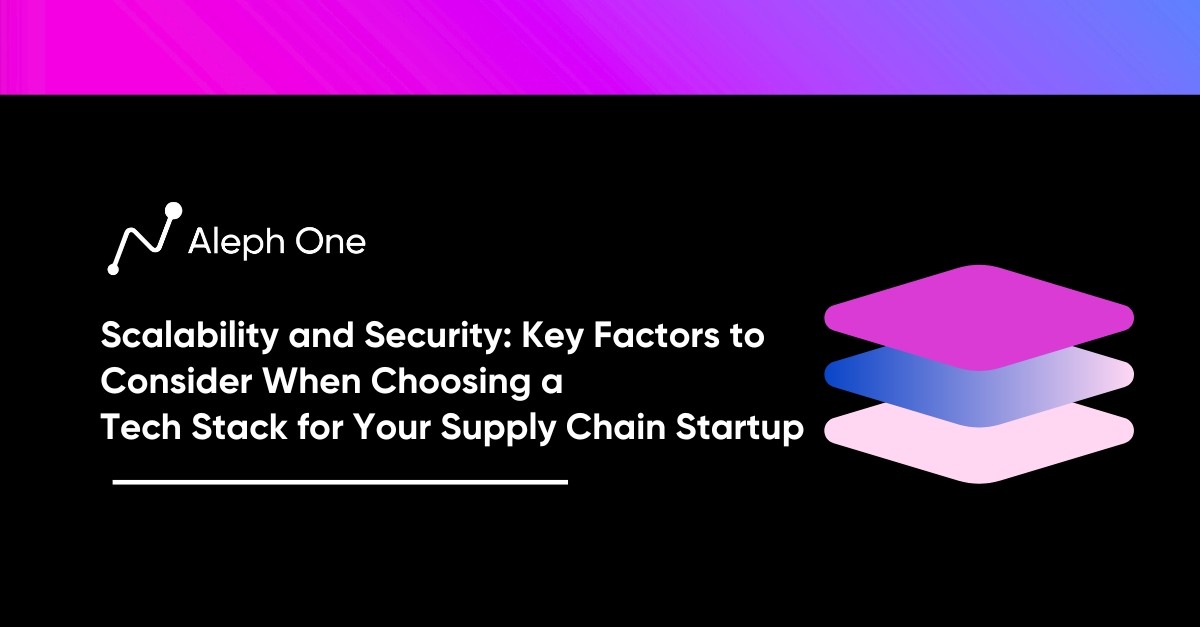Let’s work together to build something amazing. Share your project details and our team will reply to figure out the next steps to your success.

Scalability and Security are two critical factors that can make or break a supply chain startup’s success. In the ever-evolving world of technology, choosing the right tech stack becomes a paramount decision for these startups. This article delves into the importance of scalability in meeting the growing demands of customers and the repercussions of not addressing this crucial aspect. It also emphasizes the significance of security in safeguarding sensitive supply chain data from potential breaches. Furthermore, it highlights the risks of prioritizing budget-friendliness over functionality and explores how time to market can be a defining factor in gaining a competitive edge. By learning from the experiences of industry leaders and avoiding common tech stack mistakes, supply chain startups can position themselves for growth and sustainability. The right tech stack, focusing on scalability, security, and efficiency, can lay the foundation for a thriving and secure future in the dynamic supply chain landscape.

Why Scalability Should Be a Top Priority for Your Supply Chain Tech Stack
For supply chain startups, scalability is a non-negotiable factor when choosing a tech stack. You need a solution that can scale quickly to meet customer demand and support fast growth. If your technology can’t keep up with your scaling business needs, you risk frustrating customers, losing data, and stunting your growth.
Cons of Not Scaling Fast Enough
Some sobering statistics show that nearly 70% of startups fail due to scaling issues. Take restaurant delivery startup TakeOut24, for example. They struggled with an influx of new customers and couldn’t scale their tech stack fast enough, leading to delayed deliveries, lost orders, and poor customer experiences. They ended up shutting down within a year of launching.
Choose a Tech Stack for Scalability
To avoid this fate, choose a tech stack built for scalability from the start. Cloud-based solutions allow you to scale computing resources up and down as needed. Microservices architecture is also beneficial, as it means your system is built from independent, modular components that can be scaled individually. This is more flexible and cost-efficient than having to scale a monolithic system.
Scale Vertically and Horizontally
Look for a tech stack that allows you to scale vertically (adding more power to existing servers) and horizontally (adding more servers). Horizontal scaling, in particular, is important for supply chain startups, as you may need to scale massively and quickly to meet spikes in demand. The tech stack should also support automation and load balancing for seamlessly scaling your solution.
Work with Vendors and Developers
Don’t forget that your team needs to know how to scale the technology properly. Work with vendors and developers with experience building and scaling solutions for other supply chain startups. They can help you avoid common mistakes and choose a tech stack you can scale efficiently when the time comes.
While scalability may not seem urgent in the early days, it will determine whether your supply chain startup survives and thrives. The time to build a scalable tech stack is before you launch your MVP and start gaining customers. With the right scalable solution, you’ll be poised for success no matter how fast your business grows.
How to Choose a Tech Stack That Safeguards Your Supply Chain Data
Supply chain data is highly sensitive and needs to be properly secured. As a startup, your data is one of your most valuable assets, and a data breach could be catastrophic. When choosing a tech stack, security should be a top priority.
Encryption and Access Control to Protect Data
Look for technologies that offer strong encryption, access control, and other security measures to protect data at rest and in transit. For example, cloud solutions with built-in security compliance certifications like SOC 2 and ISO 27001 are good options. They have enterprise-level security protections and the certifications to prove it.
Role-based Access Control
You’ll also want tools with role-based access control to ensure only authorized individuals can access data. Require strong passwords, two-factor authentication and audit logs to monitor who accesses what data. Stay up-to-date with the latest security patches and best practices.
Security Risks
Consider the security risks of any open-source tools in your tech stack. While open source offers benefits like lower costs, you need to be sure you understand and can properly manage any vulnerabilities. If security isn’t your core competency, you may want to avoid open source altogether.
Partner with Security Experts
Look for vendors and partners with security expertise and track records serving startups in regulated industries. Ask about their security roadmaps and SLAs to ensure your needs will be met as you scale.
Supply Chain Cyber Attacks
Supply chain cyber attacks are rising, and startups are prime targets due to weaker security. Don’t be the next victim. Build security into your tech stack from the start. The data breach costs are steep, but with the right technologies and practices, you can safeguard your supply chain data and maintain your competitive advantage. Focus on security, and your customers and investors will have confidence in your growing business.
Choose technologies and partners with a focus on security. Strong encryption, access control, compliance certifications, and expert guidance are must-haves for any supply chain tech stack. Security should not be an afterthought. Build it into your strategy from day one.
Why the Most Budget-Friendly Tech Stack May Be the Worst Choice for Your Supply Chain Startup
For supply chain startups, cost is always a concern, especially in the early days. However, choosing technology primarily based on price can be a false economy. An overly basic or limited tech stack may curb your growth and require costly changes down the line.
Cheaper Tech May Slowdown as Your Business Scales
Supply chain software and systems are complex, and cheaper options often lack the functionality to handle that complexity as your business scales. They may not integrate well with other tools, leading to manual workarounds that reduce efficiency and productivity. As you gain more customers and suppliers, a tech stack unable to keep up can damage your service quality and ability to fulfill orders on time.
Barebones Tech Stack
Likewise, a barebones tech stack typically provides minimal security, leaving your sensitive supply chain data and IT infrastructure vulnerable. Breaches and cyber attacks can be catastrophic, leading to loss of funds, intellectual property, and customer trust. The financial and reputational impacts often far outweigh any initial cost savings.
Time to Market is Slower with a Simple Tech Stack
For startups especially, time to market and the ability to iterate quickly are also crucial. An overly simplistic tech stack may slow development and limit your ability to build a viable minimum viable product (MVP) that you can launch fast and improve based on user feedback.
How to Optimize Tech Stack Costs
While cost is always a factor, supply chain startups should focus first on scalability, security, and speed to market when choosing a tech stack. Options like open-source software, cloud solutions, and low-code platforms can provide the necessary functionality at a reasonable cost. You can then optimize spending in other areas like eliminating unused tools and leveraging automation.
The adage “you get what you pay for” applies here. A tech stack that cannot support your crucial business needs will cost you more in the long run. Do your research, read reviews from other startups, and invest in tools that will enable rather than limit your growth. With the right tech stack in place from the start, your supply chain startup will be poised for success.
Time to Market: Launching Fast to Gain a Competitive Edge
For supply chain startups, speed is essential. You need to get your minimum viable product (MVP) to market quickly before competitors beat you to it. However, rushing a product launch can lead to poor quality, security issues, and technical debt that hurts your startup.
Low-Code Platforms
The key is choosing a tech stack that enables rapid development without compromising quality. Low-code platforms are ideal for launching an MVP fast. These platforms provide pre-built components, modules, and integrations that minimize the need for custom coding. Startups can configure the platforms to their needs instead of building from scratch. This can cut development time by up to 90% compared to traditional code.
Shippy – Gained Customer Feedback and Additional Funding
For example, the shipping startup Shippy used a low-code platform to launch their MVP in just three months with a small team. They quickly built core features like shipment tracking, address validation, and shipping label printing. The development speed allowed them to get customer feedback and secure additional funding to scale the product.
Deliveree – Took 1+ Year to Launch MVP
In contrast, the startup Deliveree spent over a year building their MVP from the ground up. By the time they launched, competitors had already captured significant market share. Deliveree struggled to gain traction and eventually ran out of funding. Their story highlights the need for speed.
Tips to Launch an MVP Fast
Once you have an MVP, you can customize it to your specific vision using traditional coding. But the initial product should leverage the speed and flexibility of low-code platforms. Some other tips for a fast launch include:
- Focus on your core features only – avoid the temptation to build too much at first.
- Use open-source libraries and APIs whenever possible rather than building from scratch.
- Employ agile development methods like continuous integration and deployment to release updates frequently.
- Get customer feedback early and often, then iterate quickly based on input.
- Consider a “soft launch” to work out any issues before a wide release.
- Partner with experts in your tech stack who can guide your decisions and development.
With the right approach, supply chain startups can release a high-quality MVP fast. But they must be strategic in their choice of technology and development methods. Speed and scalability are essential, but never at the cost of security, functionality or sustainability. The tech stack you choose now will determine your startup’s future success.
The Top 5 Tech Stack Mistakes Supply Chain Startups Make (And How to Avoid Them)
Choosing a tech stack is one of the most important decisions a supply chain startup can make. The wrong choice can doom your startup to fail from the start. Learn from the failures of others and avoid these common tech stack mistakes:
1. Choosing a Cheap but Limited Tech Stack
Some startups choose a basic, inexpensive tech stack to save money, only to find it lacks the functionality they need to scale. For example, a startup may choose a simple ecommerce platform but soon discover it cannot support their warehousing or logistics needs. Do thorough research to find an affordable tech stack that will enable growth.
2. Failing to Plan for Scalability
Startups often struggle to scale because their tech stack cannot handle increased volume and complexity. For instance, a startup using basic spreadsheets and email may crash and burn when they try to scale to hundreds of customers and suppliers. Choose a tech stack with cloud-based solutions and APIs to integrate new applications as you grow.
3. Poor Security Practices
Startups dealing with sensitive supply chain data must prioritize security. However, some startups do not invest enough in cybersecurity measures for their tech stack, leaving customer data, intellectual property, and other assets at risk. Work with cybersecurity experts to lock down your tech stack from the start.
4. Lengthy MVP Development
Some startups spend too much time building their minimum viable product (MVP) and lose their competitive edge. Choose a flexible tech stack that allows for rapid development so you can launch your MVP fast, gain market feedback and iterate quickly. Low-code platforms and agile methodologies can help.
5. Lack of Expert Guidance
Developing a tech stack is complex, and startups often struggle without help from experts. Seek advice from supply chain leaders and CTOs to determine the best tech stack for your needs. Their real-world experience can help you avoid costly errors and build a foundation for success.
Choose the Right Tech Stack for Your Startup
With the right tech stack choices, supply chain startups can scale securely and efficiently while minimizing time to market. Learn from the failures of others, do your homework, and get expert input. Your startup’s success depends on building the best tech stack to support your competitive advantage.
FAQ
What are some examples of scalable and cost-effective tech stacks found across successful supply chain startups?
Successful supply chain startups often leverage scalable and cost-effective tech stacks like cloud-based solutions and Microservices architectures. Cloud-based solutions such as Amazon Web Services (AWS), Microsoft Azure, or Google Cloud enable businesses to scale resources up and down as needed, providing flexibility and cost-effectiveness. Microservices architecture, using technologies like Kubernetes and Docker, allows system components to be scaled individually, adding to the efficiency and adaptability of business operations.
Are there additional measures supply chain startups can do to mitigate security breaches on top of choosing a secure tech stack?
In addition to choosing a secure tech stack, supply chain startups can mitigate security breaches by implementing robust data governance frameworks, conducting frequent security audits and tests, fostering a culture of cybersecurity awareness within the team, and incorporating AI and Machine Learning for predictive threat detection and response management.
How does maximum balance between cost-efficiency, scalability, and security gets achieved while choosing a tech stack?
Achieving balance while choosing a tech stack involves careful evaluation of current and future business needs, budget constraints, and potential security threats. Startups should aim for tech stacks that offer strong scalability and security features but are within their budget. This might involve choosing open-source software, investing in scalable cloud solutions, utilizing low-code platforms, or leveraging automation to optimize spending. A comprehensive risk assessment and cost-benefit analysis can guide towards a balanced decision.
Get the latest news and updates from Aleph One in your inbox.


